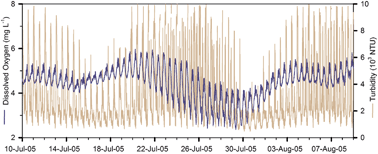Factors contributing to hypoxia in a highly turbid, macrotidal estuary (the Gironde, France)
Abstract
Dissolved oxygen (DO) is a fundamental parameter of coastal

* Corresponding authors
a
Univ. Bordeaux, EPOC, UMR 5805, F-33400 Talence, France
E-mail:
a.lanoux@epoc.u-bordeaux1.fr
b Le LyRE, Centre de Recherche de Lyonnaise des Eaux, F-33400 Talence, France
Dissolved oxygen (DO) is a fundamental parameter of coastal

 Please wait while we load your content...
Something went wrong. Try again?
Please wait while we load your content...
Something went wrong. Try again?
A. Lanoux, H. Etcheber, S. Schmidt, A. Sottolichio, G. Chabaud, M. Richard and G. Abril, Environ. Sci.: Processes Impacts, 2013, 15, 585 DOI: 10.1039/C2EM30874F
To request permission to reproduce material from this article, please go to the Copyright Clearance Center request page.
If you are an author contributing to an RSC publication, you do not need to request permission provided correct acknowledgement is given.
If you are the author of this article, you do not need to request permission to reproduce figures and diagrams provided correct acknowledgement is given. If you want to reproduce the whole article in a third-party publication (excluding your thesis/dissertation for which permission is not required) please go to the Copyright Clearance Center request page.
Read more about how to correctly acknowledge RSC content.
 Fetching data from CrossRef.
Fetching data from CrossRef.
This may take some time to load.
Loading related content
